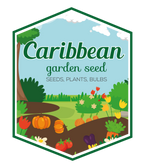The Ultimate Guide to Jute Greens: Everything You Need to Know
Introduction
Jute Greens: The Heat-Loving Egyptian Spinach Your Summer Garden Needs
When summer temperatures soar and traditional greens wilt under the scorching sun, Jute Greens (Corchorus olitorius) stand tall and vibrant. Also known as Egyptian Spinach or Molokhia, this remarkable plant has been cultivated for thousands of years along the Nile River Valley, where it earned its reputation as the "food of kings."
Unlike conventional spinach that bolts and turns bitter in hot weather, Jute Greens thrive when temperatures climb, making them the perfect addition to your summer garden. Their deep green, slightly serrated leaves offer not just heat resistance, but a nutritional profile that rivals many popular superfoods.
At Caribbean Garden Seed, we're excited to introduce many gardeners to this ancient vegetable that deserves a place in modern gardens, especially as climate patterns shift toward hotter summers across many regions.
Why Grow Jute Greens?
Exceptional Heat Tolerance
While lettuce, spinach, and many other leafy greens struggle once temperatures exceed 80°F (27°C), Jute Greens are just getting started. Native to the warm climates of Africa and Asia, these plants have evolved to withstand temperatures well into the 90s and even 100s Fahrenheit without bolting or developing bitter flavors.
This remarkable heat tolerance means you can maintain a steady harvest of nutritious greens throughout the hottest months of summer when most gardeners have given up on leafy vegetables. In fact, Jute Greens grow fastest during periods of intense heat that would devastate other garden greens.
Impressive Growth Rate
One of the most satisfying aspects of growing Jute Greens is their rapid growth rate. Plants typically reach harvest readiness in just 60 days from planting, and if left unchecked, can grow up to 6 feet tall! This vigorous growth means you can harvest repeatedly throughout the season, cutting the plants back to encourage fresh, tender growth.
Unlike one-time harvest crops, Jute Greens respond to cutting by producing new shoots, giving you multiple harvests from the same plants. This "cut-and-come-again" quality makes them incredibly economical to grow and ensures a continuous supply of fresh greens.
Rich Nutritional Profile
Jute Greens aren't just heat-tolerant—they're nutritional powerhouses. These leafy greens contain:
- High levels of beta-carotene (vitamin A precursor)
- Abundant vitamin C, E, and K
- Essential minerals including iron, calcium, and magnesium
- Dietary fiber for digestive health
- Antioxidants that help combat oxidative stress
This exceptional nutritional density explains why Jute Greens have been valued for centuries in traditional diets across the Middle East, North Africa, and parts of Asia. In Egypt, the plant is so revered that it appears in ancient hieroglyphics and was reportedly used to nurse an ailing pharaoh back to health.
Culinary Versatility
Perhaps most importantly for home gardeners, Jute Greens offer remarkable versatility in the kitchen. Young leaves can be harvested for fresh salads, while mature leaves develop a pleasant mucilaginous quality (similar to okra) when cooked, making them perfect for soups, stews, and traditional dishes.
The unique texture that develops when cooked allows Jute Greens to thicken soups naturally and creates a silky mouthfeel that many find delightful. In Egypt, the national dish Molokhia soup showcases this quality, combining the greens with garlic, coriander, and typically chicken or rabbit

![[Seeds] - Caribbeangardenseed](http://caribbeangardenseed.com/cdn/shop/files/gift-card-gift-card-1_1024x1024_dfa857db-9150-4315-a362-7f0bb3fb9c47_60x28.png?v=1722895789)